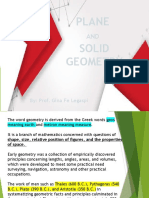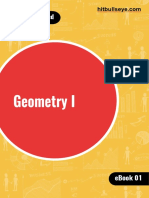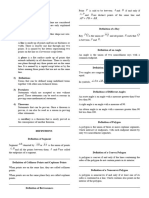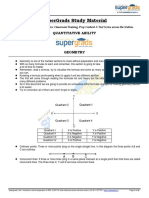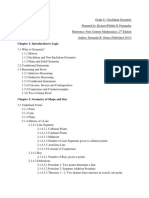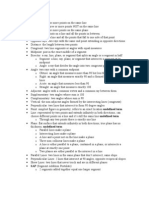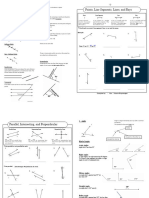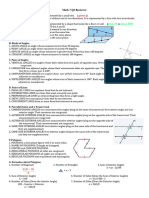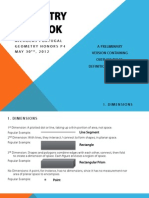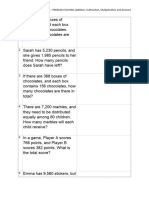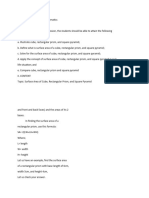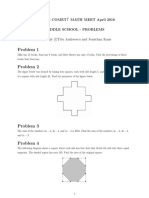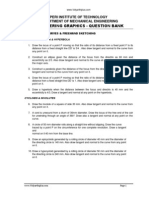Chapter 5
Geometry
In this chapter we present the standard terminologies of geometric elements.
5.1 Fundamental Ideas
1. Points and Lines
In plane geometry, certain starting concepts aren’t defined formally, but are considered
intuitively obvious. The point and the line are examples. A point can be envisioned as an
infinitely tiny sphere, having height, width, and depth all equal to zero, but nevertheless
possessing a specific location. A line can be thought of as an infinitely thin, perfectly straight,
infinitely long wire.
LINE SEGMENT
The portion of a line between two different points P and Q is called a line segment. The points P
and Q are called the end points. A line segment can theoretically include both of the end points,
only one of them, or neither of them.
If a line segment contains both end points, it is a closed line segment. If it contains one
of the end points but not the other, it is a half-open line segment. If it contains neither end point,
it is an open line segment.
RAYS (HALF LINES)
Sometimes, mathematicians talk about the portion of a geometric line that lies ‘‘on one side’’ of
a certain point. Let P and Q be two points at the same line. Imagine the set of points that starts at
P, then passes through Q, and extends onward past Q forever. This is known as a ray or half
line. The ray defined by P and Q might include the end point P, in which case it is a closed-
ended ray. If the end point is left out, the theoretical object is an open-ended ray. In either case,
the ray is said to ‘‘begin’’ at point P.
ANGLES
When two lines intersect, four angles exist at the point of intersection. Unless the two lines are
perpendicular, two of the angles are ‘‘sharp’’ and two are ‘‘dull.’’ When the two lines are
perpendicular, each of the four angles is a right angle. Angles can also be defined by sets of
three points when the points are connected by line segments.
25
�MEASURING ANGLES
The two most common units of angular measure are the degree and the radian. The degree (o) is
the unit familiar to lay people. One degree (1 o) is 1/360 of a full circle. This means that 90 o
represents a quarter circle, 180o represents a half circle, 270o represents three-quarters of a circle,
and 360o represents a full circle.
A right angle has a measure of 90o, an acute angle has a measure of more than 0o but less than
90o, and an obtuse angle has a measure of more than 90o but less than 180o. A straight angle has a
measure of 180o. A reflex angle has a measure of more than 180o but less than 360o.
ANGLE NOTATION
Imagine that P, Q, and R are three distinct points. Let L be the line segment connecting P and Q;
let M be the line segment connecting R and Q. Then the angle between L and M, as measured at
point Q in the plane defined by the three points, can be written as PQR or as RQP
ANGLE BISECTION
Suppose there is an angle PQR measuring less than 180o and defined by three points P, Q, and
R. Then there is exactly one ray M that bisects (divides in half) the angle PQR.
PERPENDICULARITY
Suppose that L is a line through points P and Q. Let R be a point not on L. Then there is exactly
one line M through point R, intersecting line L at some point S, such that M is perpendicular to L
(that is, such that M and L intersect at a right angle). The term orthogonal is sometimes used
instead of perpendicular. Another synonym for perpendicular, used especially in theoretical
physics, is normal.
PERPENDICULAR BISECTOR
Suppose that L is a line segment connecting two points P and R. Then there is one and only one
line M that is perpendicular to L and that intersects L at a point Q, such that the distance from P
to Q is equal to the distance from Q to R. That is, every line segment has exactly one
perpendicular bisector
5.2 Parallel Lines
PARALLEL LINES
Two lines are parallel if and only if they lie in the same plane and they do not intersect at any
point. Two line segments or rays that lie in the same plane are parallel if and only if, when
extended infinitely in both directions to form complete lines, those complete lines do not
intersect at any point.
COMPLEMENTARY AND SUPPLEMENTARY
Two angles that lie in the same plane are said to be complementary angles (they ‘‘complement’’
each other) if and only if the sum of their measures is 90o (π/2 rad). Two angles in the same plane
26
�are said to be supplementary angles (they ‘‘supplement’’ each other) if and only if the sum of
their measures is 180o (π rad).
ADJACENT ANGLES
Suppose that L and M are two lines that intersect at a point P. Then any two adjacent angles
between lines L and M are supplementary. This can be illustrated by drawing two intersecting
lines, and noting that pairs of adjacent angles always form a straight angle, that is, an angle of
180o determined by the intersection point and one of the two lines.
VERTICAL ANGLES
Suppose that L and M are two lines that intersect at a point P. Opposing pairs of angles are
known as vertical angles. Pairs of vertical angles always have equal measure. (The term
‘‘vertical’’ in this context is misleading; a better term would be ‘‘opposite’’ or ‘‘opposing.’’ But
a long time ago, somebody decided that ‘‘vertical’’ was good enough, and the term stuck.)
ALTERNATE INTERIOR ANGLES
Suppose that L and M are parallel lines. Let N be a line that intersects lines L and M at points P
and Q, respectively. Line N is called a transversal to the parallel lines L and M. Angles labeled x
are alternate interior angles; the same holds true for angles labeled y. Pairs of alternate interior
angles always have equal measure.
ALTERNATE EXTERIOR ANGLES
Suppose that L and M are parallel lines. Let N be a line that intersects L and M at points P and Q,
respectively. Angles labeled are alternate exterior angles; the same holds true for angles labeled
y. Pairs of alternate exterior angles always have equal measure.
5.3 Triangles
A triangle is a set of three line segments, joined pairwise at their end points, and including those
end points. The three points must not be collinear; that is, they must not all lie on the same
straight line
VERTICES
Figure 2-1 shows three points, called A, B, and C, connected by line segments to form a triangle.
The points are called the vertices of the triangle.
27
�SIDES
The sides of the triangle are named according to their end points. Thus, ABC has three sides:
line segment AB, line segment BC, and line segment CA.
INTERIOR ANGLES
Each vertex of a triangle is associated with an interior angle, which always measures more than
0o (0 rad) but less than 180o (π rad).
1
SIMILAR TRIANGLES
Two triangles are directly similar if and only if they have the same proportions in the same
rotational sense. This means that one triangle is an enlarged and/or rotated copy of the other.
Two triangles are inversely similar if and only if they are directly similar when considered in the
opposite rotational sense. In simpler terms, they are inversely similar if and only if the mirror
image of one is directly similar to the other.
CONGRUENT TRIANGLES
There is disagreement in the literature about the exact meaning of the terms congruence and
congruent when describing geometric figures in a plane. Some texts say two objects in a plane
are congruent if and only if one can be placed exactly over the other after a rigid transformation
(rotating it or moving it around, but not flipping it over). Other texts define congruence to allow
flipping over, as well as rotation and motion. Let’s stay away from that confusion, and make two
definitions. Two triangles exhibit direct congruence (they are directly congruent) if and only if
they are directly similar, and the corresponding sides have the same lengths.
Two triangles exhibit inverse congruence (they are inversely congruent) if and only if they are
inversely similar, and they are also the same size. Rotation and motion are allowed, and
mirroring is actually required.
Types of Triangles
Triangles can be categorized qualitatively (that means according to their qualities or
characteristics). Here are the most common character profiles.
ACUTE TRIANGLE
When each of the three interior angles of a triangle are acute, that triangle is called an acute
triangle. In such a triangle, none of the angles measures as much as 90o.
OBTUSE TRIANGLE
When one of the interior angles of a triangle is obtuse, that triangle is called an obtuse triangle.
Such a triangle has one obtuse interior angle, that is, one angle that measures more than 90 o.
ISOSCELES TRIANGLE
Suppose we have a triangle with sides S, T, and U, having lengths s, t, and u, respectively. Let x,
y, and z be the angles opposite sides S, T, and U, respectively. Suppose any of the following
equations hold:
s = t, t = u, s = u, x = y, y = z, x = z
28
�This kind of triangle is called an isosceles triangle
EQUILATERAL TRIANGLE
Suppose we have a triangle with sides S, T, and U, having lengths s, t, and u, respectively. Let x,
y, and z be the angles opposite sides S, T, and U, respectively. Suppose either of the following
are true:
s = t = u or x = y = z
Then the triangle is said to be an equilateral triangle
RIGHT TRIANGLE
Suppose we have a triangle PQR with sides S, T, and U, having lengths s, t, and u, respectively.
If one of the interior angles of this triangle measures 90 o, an angle that is also called a right
angle, then the triangle is called a right triangle. The side opposite the right angle is the longest
side, and is called the hypotenuse.
PERIMETER OF TRIANGLE
Suppose we have a triangle defined by points P, Q, and R, and having sides S, T, and U of
lengths s, t, and u. Then the perimeter, B, of the triangle is given by the following formula:
B=s+t+u
INTERIOR AREA OF TRIANGLE
Consider the same triangle as defined above. Let s be the base length, and let h be the height, or
the length of a perpendicular line segment between point P and side S. The interior area, A, can
be found with this formula:
A = sh/2
5.4 Quadrilaterals
A four-sided geometric plane figure is called a quadrilateral.
Types of Quadrilaterals
The categories of quadrilateral are the square, the rhombus, the rectangle, the parallelogram, the
trapezoid, and the general quadrilateral.
SQUARE
A square has four sides that are all of the same length.
29
�RHOMBUS
A rhombus is like a square in that all four sides are the same length. But the angles don’t all have
to be right angles. A square is a special type of rhombus in which all four angles happen to have
the same measure
RECTANGLE
A rectangle is like a square in that all four angles have equal measure. But the sides don’t all
have to be equally long. A square is a special type of rectangle in which all four sides happen to
be the same length.
PARALLELOGRAM
The defining characteristic of a parallelogram is that both pairs of opposite sides are parallel.
This alone is sufficient to make a plane quadrilateral qualify as a parallelogram. Whenever both
pairs of opposite sides in a quadrilateral are parallel, those pairs also have the same length. In
addition, pairs of opposite angles have equal measure. A rectangle is a special sort of
parallelogram. So is a rhombus, and so is a square
TRAPEZOID
If we remove yet another restriction from the quadrilateral, we get a trapezoid. The only rule a
trapezoid must obey is that one pair of opposite sides must be parallel.
PARALLELOGRAM DIAGONALS
Suppose we have a parallelogram defined by four points P, Q, R, and S. Let D be a line segment
connecting P and R. Then D is a minor diagonal of the parallelogram. Let E be a line segment
connecting Q and S. Then E is a major diagonal of the parallelogram
BISECTION OF PARALLELOGRAM DIAGONALS
Suppose we have a parallelogram defined by four points P, Q, R, and S. Let D be the diagonal
connecting P and R; let E be the diagonal connecting Q and S. Then D and E bisect each other at
their intersection point T.
RECTANGLE
A rectangle: a four-sided plane polygon whose interior angles are all congruent.
MEDIAN OF A TRAPEZOID
Suppose we have a trapezoid defined by four points P, Q, R, and S. Let T be the midpoint of side
PS, and let U be the midpoint of side QR. Line segment TU is called the median of trapezoid
PQRS
Perimeters and Areas
Interior area is an expression of the size of the region enclosed by a polygon, and that lies in the
same plane as all the vertices of the polygon. It is expressed in square units (or units squared).
The perimeter of a polygon is the sum of the lengths of its sides.
30
�5.5 Polygons
REGULAR PENTAGON
A five-sided polygon, all of whose sides have the same length, and all of whose interior angles
have the same measure is called a regular pentagon. It is called convex because its exterior never
bends inward. Another way of saying this is that all of the interior angles measure less than 180o.
THE REGULAR HEXAGON
A convex polygon with six sides, all of which are equally long, is called a regular hexagon.
THE REGULAR OCTAGON
A regular octagon is a convex polygon with eight sides, all equally long.
Circles and Ellipses
A circle is a geometric figure consisting of all points in a plane that is equally distant from some
center point. Imagine a flashlight with a round lens that throws a brilliant central beam of light
surrounded by a dimmer cone of light. Suppose you switch this flashlight on, and point it straight
down at the floor in a dark room. The outline of the dim light cone is a circle. If you turn the
flashlight so the entire dim light cone lands on the floor but the brilliant central light ray is not
pointed straight down, the outline of the dim light cone is an ellipse. The circle and the ellipse
are examples of conic sections. This term arises from the fact that both the circle and the ellipse
can be defined as sets of points resulting from the intersection of a plane with a cone.
5.6 Geometric Solids
1. Prism
Prisms are solids (three-dimensional figures) that occupy space. They come in many shapes and
sizes. Every prism has the following characteristics:
Bases: A prism has two bases, which are congruent polygons lying in parallel planes.
Lateral edges: The lines formed by connecting the corresponding vertices, which form a
sequence of parallel segments
Lateral faces: The parallelograms formed by the lateral edges.
Altitude: A segment perpendicular to the planes of the bases with an endpoint in each plane
Oblique prism: A prism whose lateral edges are not perpendicular to the base
Right prism: A prism whose lateral edges are perpendicular to the bases. In a right prism, a
lateral edges is also an altitude.
Right Prisms
31
�In certain prisms, the lateral faces are each perpendicular to the plane of the base (or bases if
there is more than one). These are known as a group as right prisms.
The lateral area of a right prism is the sum of the areas of all the lateral faces
The total area of a right prism is the sum of the lateral area and the areas of the two bases.
Because the bases are congruent, their areas are equal
Lateral area and total area are measurements of the surface of a solid. The interior space of a solid
can also be measured.
A cube is a square right prism whose lateral edges are the same length as a side of the base
The volume of a solid is the number of cubes with unit edge necessary to entirely fill the interior
of the solid.
Right Circular Cylinders
A prism-shaped solid whose bases are circles is a cylinder. If the segment joining the centers of the
circles of a cylinder is perpendicular to the planes of the bases, the cylinder is a right circular
cylinder.
Pyramid
A pyramid is a solid that has the following characteristics
It has one base, which is a polygon
The vertices of the base are each joined to a point, not in the plane of the base. This point
is called the vertex of the pyramid
The triangular sides, all of which meet at the vertex, are its lateral faces.
The segments where the lateral faces intersect are lateral edges
The perpendicular segment from the vertex to the plane of the base is the altitude of the
pyramid
Regular Pyramids
32
�A regular pyramid is a pyramid whose base is a regular polygon and whose lateral edges are all
equal in length. A pyramid is named by its base
The lateral faces of a regular pyramid are congruent isosceles triangles. The altitude of any of these
triangles is the slant height of the regular pyramid.
Right Circular Cones
A right circular cone is similar to a regular pyramid except that its base is a circle. The vocabulary
and equations pertaining to the right circular cone are similar to those for the regular pyramid.
Spheres
A sphere is the set of all points in space that are equidistant from a fixed point (the center). That
distance is the radius of the sphere. Because a sphere has no bases, its area is referred to as its
surface area.
33
� Appendix
1. Types of Angles
2. Circle
34
�3. Types of Triangles
35
�4. Polygons
36
�5. Complementary Angles
6. Suplementary Angles
37
�7. Vertical Angles
For any two lines that meet, such as in the diagram below, angle AEB and angle DEC are called
vertical angles. Vertical angles have the same degree measurement. Angle BEC and angle AED
are also vertical angles.
38
�8. Alternate Interior Angles
9. Alternate Exterior Angles
For any pair of parallel lines 1 and 2, that are both intersected by a third line, such as line 3 in
the diagram below, angle A and angle D are called alternate exterior angles. Alternate
exterior angles have the same degree measurement. Angle B and angle C are also alternate
exterior angles.
39
�10. Corresponding Angles
For any pair of parallel lines 1 and 2, that are both intersected by a third line, such as line 3 in
the diagram below, angle A and angle C are called corresponding angles. Corresponding
angles have the same degree measurement. Angle B and angle D are also corresponding
angles.
11. Angle Bisector
An angle bisector is a ray that divides an angle into two equal angles.
40
�The red ray on the right is the angle bisector of the angle on the left.
12. Space Geometry
a. Cylinder
b. Cone
41
�c. Sphere
d. Cuboid
42
�e. Prism
f. Pyramid
43
�Exercise
1. Create sentences using the following words:
a. angle
b. triangle
c. quadrilateral
d. circle
e. rhombus
2. Create sentences using the following words:
a. cylinder
b. cone
c. sphere
d. cuboid
e. prism
44











